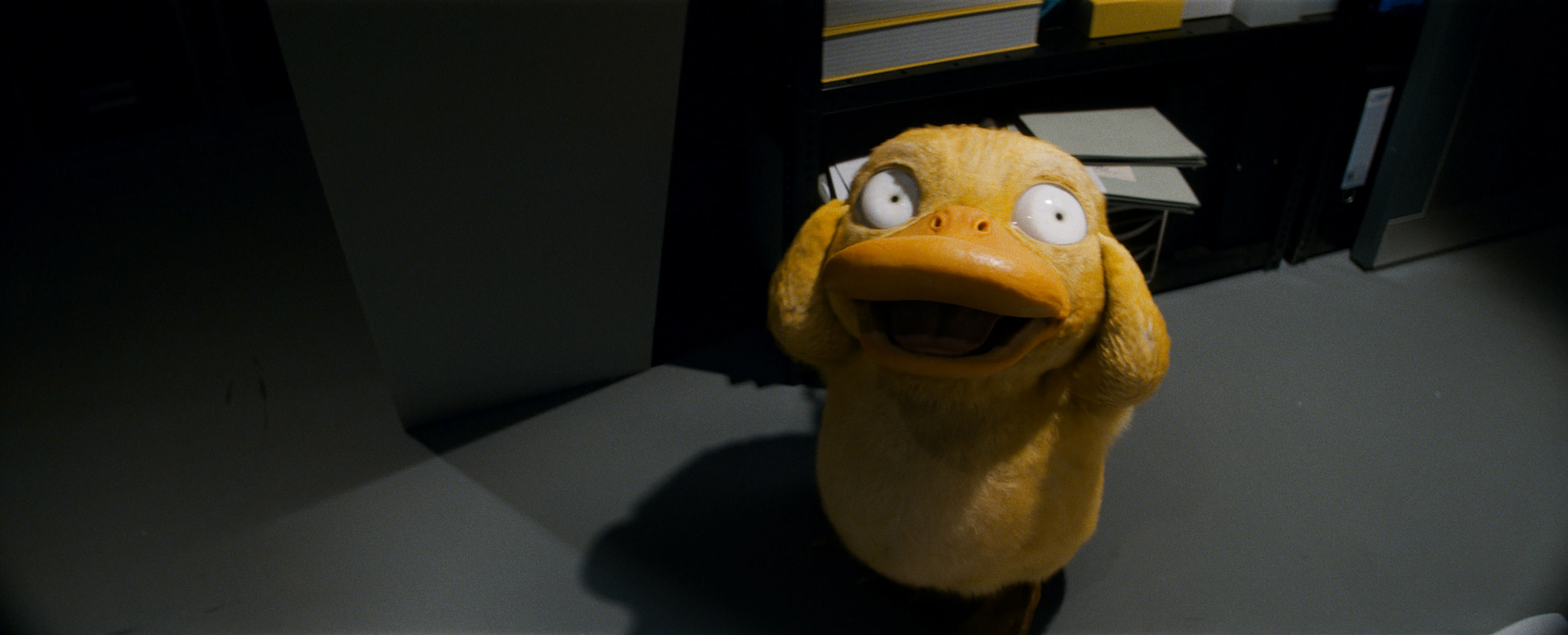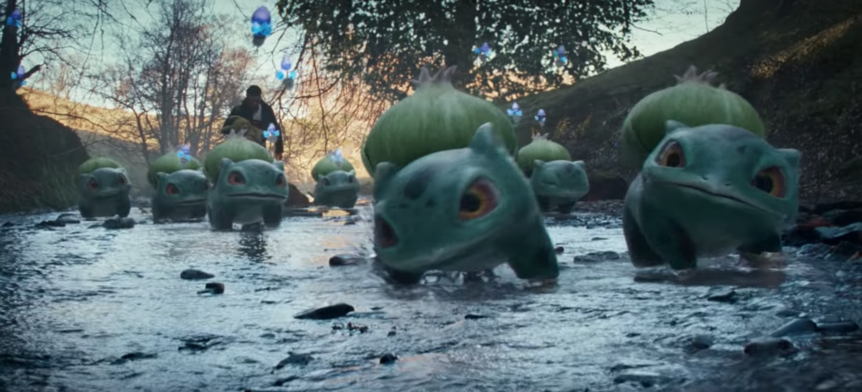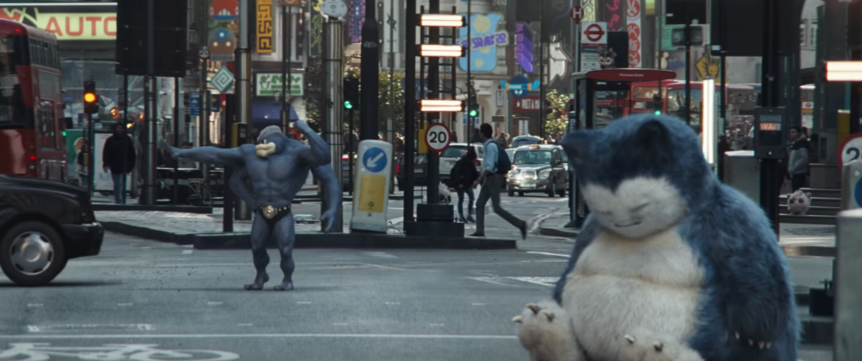Create a free profile to get unlimited access to exclusive videos, sweepstakes, and more!
Why Psyduck — yes, Psyduck — was the key Pokémon in Detective Pikachu

When Benji Samit and Dan Hernandez were brought on to help write Pokémon Detective Pikachu, it was a dream come true for two lifelong nerds. They grew up playing the original Pokémon video games on Nintendo Gameboy and mashing buttons as pocket monsters on Super Smash Bros., and suddenly they were being asked to shape the first live-action movie in the franchise's decades-long history. The creative choices that lay ahead of them were manifold, and their fandom colored their decision-making from the start.
"From day one of working on the movie, one of our very first pitches to the producers was hey, we think Psyduck should be in it, even though we know that character does not exist in the [Detective Pikachu] game," Samit told SYFY WIRE in a conversation last week, laughing at the admission. "From the very beginning, having Psyduck as the number two Pokémon after Pikachu, that was put in just because he's our favorite and has always been our favorite."
Hernandez, in particular, holds a special affinity for Psyduck, who could be fairly described as a neurotic yellow duck who might be played by the character actor Richard Kind in some kind of body horror version of a Pokémon movie.
"Because I'm a neurotic writer, I really relate to getting stressed and more stressed and more stressed and then just exploding," Hernandez said, laughing at himself. "And for that reason, I've always felt a great kinship to Psyduck, so we thought that was really important to get him in there."
It also helped that Psyduck's personality jived with that of Lucy (played by Kathryn Newton), a character who will be new to audiences both steeped in Pokémon lore and casual fans of the franchise. Quickly establishing characters with the assistance of their better-known Pokémon counterparts was actually a shrewd move by the writers, who faced a series of story challenges based on the source material. For as popular the franchise has become with generations of gamers and fans, Detective Pikachu is based on a little-known offshoot Pokémon game that featured few of the traditional characters and story elements that have become hallmarks of the series.
Detective Pikachu, directed by Rob Letterman, follows a sullen early twenty-something named Tim Goodman (Justice Smith) as he heads to Ryme City to handle the affairs left by his father, a cop named Harry who is presumed dead after his car is thrown from a bridge in a fiery crash. Tim, disillusioned after a childhood spent obsessed with Pokémon, is greeted at Harry's apartment by a Pikachu with whom he can somehow verbally communicate.
This Pikachu, a caffeine addict with the kind of sarcastic sense of humor that is inherent with a Ryan Reynolds voice performance, isn't convinced that Harry is dead, and he forces Tim on a conspiracy-fueled hunt that takes them all through the city. And Ryme City is unlike any other region in any other Pokémon movie and game; instead of being kept as pets or trained for battle, Pokémon there are part of the fabric of everyday life, working in civil service jobs and the private sector alike. It's pitched as a more enlightened society, which meant that they were integrated into the urban grind in ways not seen at any point in the games.
"When we're making the first live-action Pokémon movie, we wanted to give it a reason to exist," Hernandez said. "Like, why now are we making a live-action Pokemon? So we wanted to show this world as real as possible. What is the reality of a world where every animal is this fantastical creature living among us?"
Ryme City looks like a futuristic mix of Tokyo and New York, with gleaming skyscrapers and busy street food markets tucked away in hidden alleyways. Pokémon are integrated into the action, acting as something akin to service animals (and quite frequently, self-aware troublemakers). The scene in which Tim first arrives in the city was conceived as something akin to stepping outside Grand Central Station, only with working Pokémon weaved in.
In the interest of populating the world and including as many creatures as possible, Samit and Hernandez's script was more detailed than most, filling each scene up with an assortment of Pokémon plucked from every current iteration of the game. They specifically mentioned about a dozen pocket monsters in their written descriptions of the first big Ryme City sequence, which wound up with maybe double that once Letterman and his post-production crew were finished.
As fans of the original 151, Samit and Hernandez admit to having a bit of a bias towards some foundational Pokémon, and "wanted to pay homage to the deep history" of the franchise, while also including favorites from new generations. That meant old favorite Squirtle was enlisted in the Ryme City Fire Department and worked as cleanup crew on a TV set, while Charmander, another original starter Pokémon in the original Gameboy game, was used to light stoves. In the lone underground battle we witness, Charizard reigns supreme.
Meanwhile, Machamp, a blue bodybuilding Pokémon, is a cop directing traffic, while a Pidgey carries packages for a courier service that's found a way around having to buzz every single apartment in a building to make deliveries. Jigglypuff is a lounge-singer, though it's unclear whether it's being paid for its labor.
Newer Pokémon in the workforce include a Ludicolo working as a bartender, Loudreds serving as club speakers, and Joktiks providing energy on power lines.
Not all of the writers' suggestions made it into final cut, and the ones that missed the big screen give an indication of just how comprehensively thought-out they imagined this world.
"There were some fun urban ones like Garbodor," Hernandez reveals. "We had Smeargle doing graffiti art at one point, just kind of in the background. Meowth was one that that would have been a lot of fun but just didn't quite work out. But a Garbodor was the one I really wanted because I felt like that made the most sense, with the garbage collection."
The vast number of creatures all throughout the film offered another special challenge. Though only Pikachu can speak intelligible English, every Pokémon is endowed with the ability to say their own name — and often. And they're not just guttural roars, but the equivalent of meaningful dialogue, with all the timing and implications of full sentences. Again, their script dwelled on the is individual details, and a chorus of Pokémon names are scattered across the pages.
Once again, Psyduck took center stage.
"It was fun writing dialogue where we changed how many 'u's' there were in Psyduck," Samit said, laughing. "Or making it 'Psy. Duck,' when he was pissed off. Or 'Psyduuuck' when he was satisfied."
There are also a few nods to the franchise's past and its legacy in other media platforms. Tim collects Pokémon cards, and at one point, Pikachu sings a verse from the iconic original anime theme song. There is also a parade with giant balloons modeled after the original anime series' creature designs. It's part meta fan-service and Easter egg placement, but it also raises several questions, with answers that further reveal the depth of the world created here.
When asked if there was a Pokémon anime within the world of Detective Pikachu, the writers noted that "the deep history of this world is present in the world of Detective Pikachu," pointing to the fact that the film's Mewtwo is the same one that escaped in the events of the first Pokémon movie, which was released 20 years ago.
"It's all connected, it's all a part of the greater Pokémon universe," Samit teased.
















